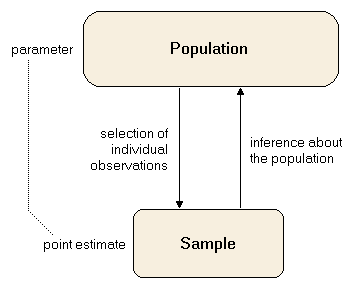| Fundamentals of Statistics contains material of various lectures and courses of H. Lohninger on statistics, data analysis and chemometrics......click here for more. |

|

Home  Basic Concepts Basic Concepts  Definition of basic terms Definition of basic terms  Population and Sample Population and Sample |
|||||
| See also: Venn diagram, parameters, distribution, random variable, representative samples | |||||
Population and Sample
The population, which is the basis of a statistical survey, has always to be defined in an exact way (which is not always easy) in order make sure that the results are comparable. The best way to go is to define not only the factual prerequisites ("what has to be analysed") but also the spatio-temporal general framework. In our example of 500 balls, the size of the population is finite. In many cases - especially with real measurements - the population size is infinite. For example, if the variable of interest is the concentration of oxygen in air, measured with some analytical device. The population is the (infinite) set of all (possible) measurements (= results derived from the analytical instrument).
Another example is the number of cars driving on a particular section of a highway in the morning between 7am and 10am. The population of this variable is the number of cars using this highway during the defined time interval each day - as long as the highway exists.
|
|||||
Home  Basic Concepts Basic Concepts  Definition of basic terms Definition of basic terms  Population and Sample Population and Sample |
|||||


 In applied statistics, we have to differentiate strictly between populations and samples. Consider a box containing 500 balls of three different colors. This set of balls is called the population. Descriptive statistical measures e.g. the
In applied statistics, we have to differentiate strictly between populations and samples. Consider a box containing 500 balls of three different colors. This set of balls is called the population. Descriptive statistical measures e.g. the